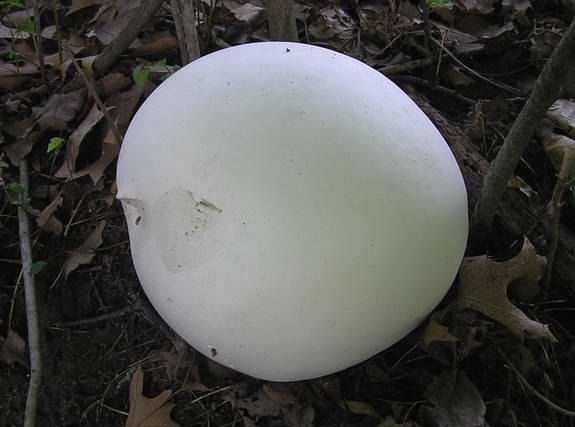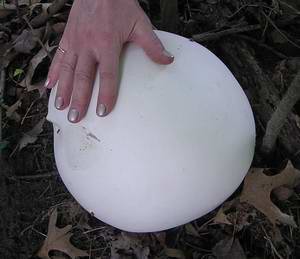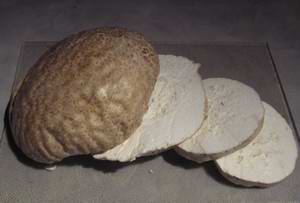|
Return to Hiker's Notebook Home Page
Common Name: Giant Puffball - The giant ball-shaped fungus is filled with spores that "puff" out when the outer wall (peridium) disintegrates. The common names in French are much more descriptive: Vesse de loup g�ante, literally translates as 'giant wolf fart' and refers to the puffing of the spores - the lupine metaphor is much more graphic; T�te de mort literally means the 'head of the dead' since the fungus looks like a skull; old, dried specimens found in basements have been mistaken for bleached skulls. The more practical Germans call it St�ubling Riesenbovist, which is something like the giant (reisen) thing that puffs (st�ub).
Scientific Name: Calvatia gigantea - The Latin word for bald (without hair) is calvus, the root for the generic name for the fungus; the species name is from the Latin gigant, meaning giant. Taken together, the scientific name would translate to 'giant bald head.' Formerly known as Langermania gigantea and Lycoperdon gigantea.
The giant puffball is among the most readily recognizable of all the fungi due not only to its gargantuan size, but to its globular shape. It is a Gastromycete, a division of the Basidiomycetes (gilled fungi) that are characterized by the production of spores internally in a "spore sac" - gastro is from the Greek gaster meaning belly or paunch. The interior of puffballs is known as the gleba, which is the Latin word for a "lump or clod of earth," which is what it looks like. The mechanism of spore dissemination is the basis for the term puffball; as the fungus matures, the spores form from the spongy, solid white interior or gleba. After a few weeks of growth, the thin outer perideal (skin) layer breaks into areolate (hollowed) patches which flake off exposing the inner perideal layer which cracks into irregular fragments; this exposes the now particulate spores that are wafted away by the wind to settle and replicate.
The Brobdingnagian size of the mature giant puffball in comparison to the
Lilliputian spores that it contains has long been a matter of some curiosity.
Specimens as large as 5 feet in diameter and weighing up to 50 pounds have
been reported. According to Bryce Kendrick in The Fifth Kingdom "a
Canadian specimen collected in 1987 held the wo
David Aurora, in his seminal work Mushrooms Demystified, carries the size analogy to astronomical extremes to emphasize its enormity. If each spore were laid end to end they would "circle the earth at the equator." Mathematically, 7 x 1012 spores each with a diameter of 5 x 10-6 meters is 35 x 106 meters or 35,000 kilometers, within 10 percent of the mean circumference of about 40,000 kilometers (25,000 miles). To continue, if each of the 7 trillion spores grew into a giant puffball, then the line of puffballs would stretch "to the sun and back" (186 million miles) and weigh "800 times as much as the earth." Actually, 7 trillion decimeters is about 700 million kilometers, or about 420 million miles, to the sun and back at least twice. The earth has a mass of about 6 x 1024 kilograms; 7 trillion giant puffballs each weighing about a kilogram is only 7 x 1015 kilograms - about the size of Eros, one of the larger asteroids but not even close to the mass of one earth, let alone 800. The precarious journey of a puffball spore to successful germination is evident here, as only a handful out of 7 trillion succeed in producing a full-grown giant puffball. Aurora also notes that a particularly nefarious-looking puffball was found in England during World War II and used in an exhibition to stir up public opinion as "Hitler's secret weapon."
The spectacular appearance of the large white globular fungus doubtless brought the giant puffball to the attention of early hominids. It likely was one of the first of the fungi to be gathered and brought back to the camp to become the cynosure for curious discussion and, ultimately, initial experimentation. Native Americans offer at least some anecdotal evidence of this, as their oral histories have survived. Though there is no indication that they were consumed as food, puffballs were certainly used as a means to stanch a wound; the puffball spores have an anticoagulant effect. The emanations from a burning puffball were used to smoke out beehives in order to retrieve the honey, it having been noted that the fumes had an anesthetic effect.
The practice of stanching wounds with puffballs extended to inserting dried puffballs into the nostrils to treat epistaxis, more commonly known as nosebleed. Over time, it was discovered that nasal use could result in inflammation of the lungs if the puffball was of spore-release maturity; puffballs are sometimes called the "devil's snuffbox" due to this effect. In 1994, eight teenagers in Wisconsin were hospitalized due to the inhalation of puffball spores (allegedly to achieve a hallucinogenic effect often attributed to mushrooms). They all experienced coughing, fever, shortness of breath, and fatigue; five were hospitalized and two required transbronchial lung biopsy that revealed the presence of yeast-like structures consistent with puffball spores. All survived.
Because giant puffballs are so easy to identify without the need for a skilled mycologist, they are consumed by a larger proportion of the wild-food gatherers than mushrooms with a high degree of variance and some unpleasant look-alikes (e. g. the edible Chanterelle - Cantharellus cibarius and the poisonous Jack-O-Lantern - Omphalotus olearius). As long as the gleba is completely white with a marshmallow-like consistency, they are safe to eat; there are no poisonous giant puffball look-alikes. However, like all fungi, they can have purgative effects on certain individuals and should accordingly be consumed with some moderation.
An excellent
recipe for giant puffball is to cut it into slices like loaf of bread and to
make a batter with an egg beaten into a froth with a fork. The sliced puffball
sections are then dipped in the batter |

 rld
record until 2000 for the largest edible fungus - 2.64 meters in circumference
and weighing 22 kilograms." The number of spores is generally reported as 7
trillion in a medium sized giant puffball. The mathematics is fairly simple.
Each spore has a radius of about 5 microns or 5 X 10-6 meters and
the giant puffball that contains them has a radius of about a decimeter - 10
centimeters, or 10 x 10-2 meters. The volume of a sphere is
proportional to the cube of the radius. When you cube an exponential number,
you simply multiply the exponent by 3 (which is one of the reasons why people
use exponents). Therefore the volume of the giant puffball is on the order of
10-6 cubic meters and each individual spore is on the order of 10-18
cubic meters. The difference is 12 orders of magnitude (18 - 6). A trillion is
1 x 1012, 12 orders of magnitude - so there are about 7 trillion
spores in a giant puffball.
rld
record until 2000 for the largest edible fungus - 2.64 meters in circumference
and weighing 22 kilograms." The number of spores is generally reported as 7
trillion in a medium sized giant puffball. The mathematics is fairly simple.
Each spore has a radius of about 5 microns or 5 X 10-6 meters and
the giant puffball that contains them has a radius of about a decimeter - 10
centimeters, or 10 x 10-2 meters. The volume of a sphere is
proportional to the cube of the radius. When you cube an exponential number,
you simply multiply the exponent by 3 (which is one of the reasons why people
use exponents). Therefore the volume of the giant puffball is on the order of
10-6 cubic meters and each individual spore is on the order of 10-18
cubic meters. The difference is 12 orders of magnitude (18 - 6). A trillion is
1 x 1012, 12 orders of magnitude - so there are about 7 trillion
spores in a giant puffball.
 ,
,
